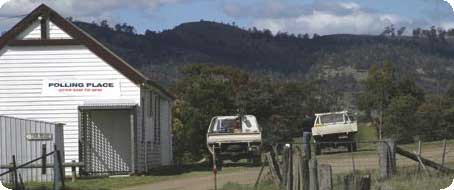Election Day
In this Section:
Election day is always on a Saturday and must be at least 33 days after the issue of the writs. For the 2004 federal election, election day was Saturday 9 October 2004.
Polling places
At the 2004 federal election, there were 7 729 polling places operating on election day. They were set up mainly in schools or community halls with the DRO in each division having selected the premises as part of their election preparations. As far as practicable, and given the limited notice of an election, DROs select available buildings which have wheelchair access. All polling places were advertised in major newspapers on the Friday before election day and the places with full wheelchair access and access with assistance were identified. A list of polling places for the 2004 federal election was also published on the AEC website.
Polling places were open between the hours of 8am and 6pm.
Polling places were staffed by the following people:
- an Officer in Charge (OIC)
- a Second in Charge (2IC) at large polling places
- an Inquiry officer at large polling places
- declaration vote issuing officers
- ordinary vote issuing officers
- a ballot box guard
- a queue controller at large polling places
The doors to the polling places shut at 6pm sharp. Electors inside at closing time were able to complete their vote but no one else was able to enter to vote.
The majority of electors cast an ordinary vote in the 2004 federal election. In addition, interstate polling places were available at a number of locations for electors not in their home State or Territory to cast their vote on election day.
How-to-vote cards
Walking towards the entrance of a polling place, electors are usually offered how-to-vote cards by political party workers and representatives of other candidates. Electors are not required to accept these cards and by law these workers must remain six metres away from the entrance of the polling place.
The how-to-vote cards show how particular candidates would like electors to fill in their ballot papers and electors are able to take a card in with them when they vote. Electors may choose to ignore the cards if they wish.
Issuing of ballot papers
Each elector was asked the following three questions by a polling official before they were issued with their ballot papers:
- What is your full name?
- What is your address?
- Have you voted before in this election?
Polling officials were able to ask for additional information, such as the elector’s date of birth, where necessary, to assist them in identifying the elector’s name on the Certified List.
The official then placed a mark next to the elector’s name on the Certified List, initialled the ballot papers and handed them to the elector.
Each elector was issued with one green ballot paper for the House of Representatives and one white ballot paper for the Senate.
Each elector then went alone to a voting screen to mark their ballot papers in privacy. Under the Act the AEC must provide separate voting compartments to ensure the secrecy of the vote.
Each voting compartment is provided with a pencil but electors may use their own pen if they wish. The elector then folds their completed ballot papers and places each ballot paper into a ballot box.
The polling place in Australia that issued the most votes in 2004 was Narre Warren South in the Division of Holt (Victoria). It issued 7 823 votes on election day.
Declaration Votes
In addition to issuing ordinary votes, declaration officers at each polling place issues absent and provisional votes during the day. Electors casting these types of votes are required to fill in a declaration envelope into which they put their completed ballot papers. The sealed declaration envelope is then put into the ballot box.
Scrutineers during polling
Candidates are not permitted to take part in the actual conduct of an election. However, they may appoint scrutineers as personal representatives to observe both the voting and the counting of votes at every polling place.

Tea Tree public hall in Tasmania, one of over 7000 polling places open on election day.
